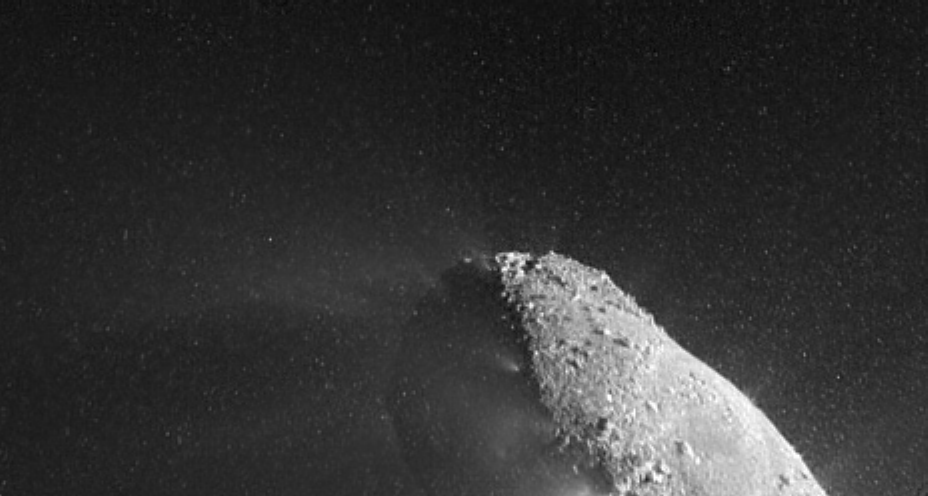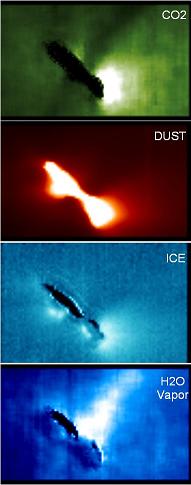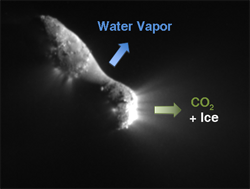EPOXI
Two intriguing investigations -- One flight-proven spacecraft
News: Spacecraft Flew Through 'Snowstorm' on Encounter with Comet Hartley 2, 2010.11.18
Press Release
Spacecraft Flew Through 'Snowstorm' on Encounter with Comet Hartley 22010.11.18

COLLEGE PARK, Md. -- On its recent trip by comet Hartley 2, the Deep Impact spacecraft took the first pictures of, and flew through, a storm of fluffy particles of water ice being spewed out by carbon dioxide jets coming from the rough ends of the comet. The resulting images and data shed new light on the nature and composition of comets, according to the University of Maryland-led EPOXI science team, which today announced its latest findings and released the first images of this comet created snowstorm.
"When we visited Hartley 2, it was in the midst of a cometary ice storm generated by jets of carbon dioxide gas carrying a couple of tons of water ice off the comet every second," said University of Maryland astronomer Michael A'Hearn, science team leader and principal investigator for the spacecraft's Deep Impact and EPOXI missions. "At the same time, a different process was causing water vapor to come out of the comet's mid-section."

"This is the first time we've ever seen individual chunks of ice in the cloud around a comet or jets definitively powered by carbon dioxide gas," said A'Hearn, who won the 2008 Kuiper astronomy prize for seminal contributions over his career to the study of comets. "We looked for, but didn't see such ice particles around Tempel 1."
According to A'Hearn evidence of large chunks around comets including Hartley 2 has been found with the Arecibo Radio telescope, but Arecibo can't detect individual particles or determine what the chunks are made of. Around Hartley 2, the spacecraft clearly imaged clouds of large ice particles with the largest ranging from golf ball sized to the size of a basketball.
"When we first saw all the specks surrounding the nucleus, our mouths dropped," said EPOXI mission co-investigator Pete Schultz of Brown University. "Stereo images reveal that there are snowballs in front and behind the nucleus, making it look like a scene in one of those crystal snow globes."
A Changing Comet Picture
According to A'Hearn, Schultz, and University of Maryland astronomer Jessica Sunshine, the new findings show that Hartley 2 "works" quite differently than Tempel 1 or the other three comets with nuclei imaged by spacecraft. "CO2 appears to be a key to understanding Hartley 2, and explains why the smooth and rough areas of the comet respond differently to solar heating and have different mechanisms by which water comes out of the interior of the comet," said Sunshine, who is the EPOXI deputy principal investigator.
"CO2 jets blast out water ice from specific locations in the rough areas resulting in a cloud of ice and 'snow,'" Sunshine explained. "Underneath the smooth middle area, water ice evaporates into water vapor that flows through the porous material with the result that close to the comet in this area we see a lot of water vapor."

According to Sunshine and the other members of the science team, the smooth area of comet Hartley 2, looks and behaves like most of the surface of comet Tempel 1, with water evaporating below the surface and percolating out through the dust. However the rough areas of Hartley 2, with CO2 jets spraying out ice particles, are very different.
A'Hearn said that more detailed analysis will be needed to determine whether the difference in out gassing between the smooth and rough regions of the comet likely is the result of a mixing of dry-ice rich clumps with dry-ice poor clumps during the comet's formation some 4.5 billion years ago, or whether that difference is due to more recent evolutionary changes.
The Deep Impact spacecraft has three instruments -- two telescopes with digital color cameras and an infrared spectrometer. The spectrometer measures the absorption, emission and reflection of light that is unique (spectroscopic signature) to each molecular compound or element. It is this instrument that allows Maryland scientists to identify the CO2 gas, water ice, water vapor and other materials seen on the comet's surface, in the jets, and in the coma, or cloud of particles and gas, around it.
The science team released the first images from the High Resolution Imager (HRI), the stronger of the spacecraft's two telescopes. The images clearly show clouds of icy particles above the elongated nucleus of Hartley, which is 1.4 miles (2.2 km) in length and 0.25 miles (0.4 km) wide at the neck.
The HRI can provide images with tremendous detail, but it takes much longer to process these images than those from the smaller MRI telescope. HRI images require computerized and manual correction, or deconvolution, to compensate for the fact that the telescope is slightly out of focus.
A Deeper Impact on Comet Science
With its latest EPOXI mission data, the Deep Impact spacecraft is adding to an already extensive scientific legacy. Launched in January 2005, the spacecraft made history and world-wide headlines when it smashed a probe into comet Tempel 1 on July 4th of that year. Following the conclusion of that mission, a Maryland-led team of scientists won approval from NASA to fly the Deep Impact spacecraft to a second comet.
EPOXI is a combination of the names for the extended mission's two components: the Extrasolar Planet Observations and Characterization (EPOCh), and the flyby of comet Hartley 2, called the Deep Impact Extended Investigation (DIXI). During the initial phases of EPOXI, the Deep Impact spacecraft provided information on possible extrasolar planets, imaged Earth to provide "colorful" findings that someday may help identify earthlike worlds around other stars and was one of three spacecraft to find for the first time clear evidence of water on the Moon.
NASA's Jet Propulsion Laboratory, Pasadena, Calif., manages the EPOXI mission for NASA's Science Mission Directorate, Washington. The University of Maryland, College Park, is home to the mission's principal investigator, Michael A'Hearn and ten other members of the EPOXI science team. Drake Deming of NASA's Goddard Space Flight Center, Greenbelt, Md., is the science lead for the mission's extrasolar planet observations. The spacecraft was built for NASA by Ball Aerospace & Technologies Corp., Boulder, Colo.
Files from Press Briefing
- Hartley 2, Close Up
- Cometary Flurries
- Tempel 1 and Hartley 2
- H20 Diffuse Sublimation
- CO2 Jet Process
- Particles Everywhere
- Views of Hartley 2 and Inner Coma
- Icy Particle Spray
- Tracking 'Snowballs'
- Hartley 2 in 3-D
- Nearby Snowpuffs
- Approach Movie -- Flying Past a Comet
- Gases in the Coma of Hartley 2
- Ice in the Coma of Hartley 2
- The Many Faces of Hartley 2
Replay
Lee Tune
University of Maryland, College Park
301-405-4679
ltune [at] umd [dot] edu
Jia-Rui Cook
Jet Propulsion Laboratory, Pasadena, Calif
818-359-3241
jccook [at] jpl [dot] nasa [dot] gov
Dwayne Brown
Headquarters, Washington
202-358-1726
dwayne.c.brown [at] nasa [dot] gov
RELEASE: 10215, Source
